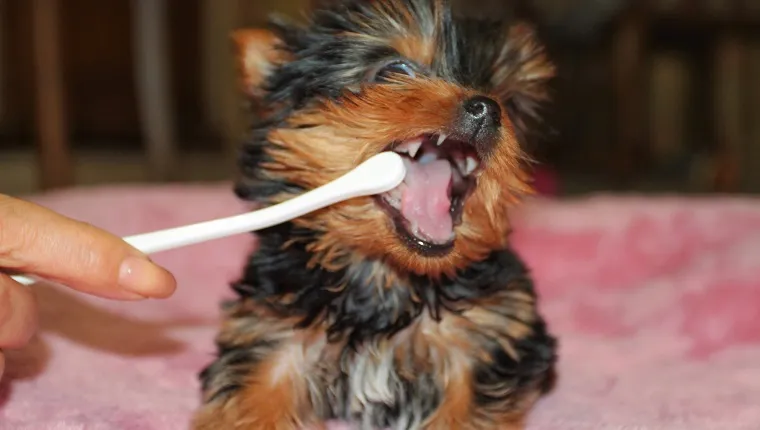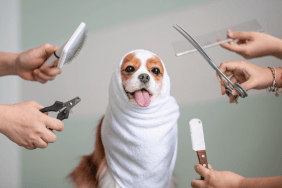February is Pet Dental Health Month, so let’s spread the word about gum disease in dogs and try to educate fellow pet parents.
By the age of three, more than 80 percent of dogs show signs of gum disease, according to the American Veterinarian Dental Society. It’s no surprise, then, to learn that two-thirds of dog parents aren’t giving their pets the recommended dental care.
If left untreated, gum disease leads to tooth decay and tooth loss. Other problems, such as a chipped or fractured tooth, can cause infection, which may necessitate extracting the tooth. Worse still, untreated problems can have a domino effect on overall health, leading to heart, lung, and kidney disease.
While it may not be a priority for many pet parents, dental care is serious business for your dog, especially since dogs so often use their mouths to interact with the world.
Fortunately, dental care is one area where dog lovers can have a significant positive impact without too much effort. To tell the truth, it’s a lot like taking care of your own teeth: simple steps taken now can prevent many problems — and expenses — down the road.
When It’s Time To See A Vet

Regardless of your diligence with your dog’s dental care, it’s important to have your vet examine their teeth and gums at least once a year. This is the best way to catch problems before they become too serious.
If there’s a problem with your dog’s teeth, the first sign is often bad breath, caused when bacteria begin to multiply in food trapped between teeth or at the site of an infection. Other signs to watch for include:
- Drooling more than normal
- Reluctance to chew food or toys
- Misaligned teeth
- Missing teeth or failure to develop adult teeth
- Redness, swelling, or bleeding around the gums
What’s Next
Treatments for your dog’s dental problems will vary, depending on the source of the trouble. Solutions range from simple brushing at home to get rid of bad breath to medication or surgery for more serious problems.
Your veterinarian will give you recommendations for further treatment and at-home care. They can provide you with instructions for brushing your dog’s teeth at home, an appropriate diet that promotes oral health, and signs of gum disease to be on the lookout for.
How To Prevent Dog Dental Problems

With your vet’s guidance, you can take these easy steps at home to help keep your dog’s teeth shiny, healthy, and clean:
- Feed them an appropriate diet: Your vet will advise you on which foods your dog can eat that will keep their mouth healthy. They may also recommend switching out your dog’s regular treats once in a while for dental chews, like Greenies.
- Provide the right toys: Never let a dog play with an object that’s harder than their teeth or one that’s small enough for them to swallow. Chewing is a great way to promote oral health. However, you must make sure you’re giving your dog toys that are safe. A good, sturdy rope toy to play tug-of-war will exercise your dog’s jaw muscles and help clean their teeth. Remember to put all toys, bones, and chews away when they’re not in use. If your dog is a strong chewer, pick stronger toys that won’t fall apart and become a choking hazard.
- Brush! Your vet can advise you on how often to brush your dog’s teeth. Many advise brushing at least three times a week using a soft toothbrush. Starting this habit early can make it a pleasant and fun experience for you and your dog. Be sure to use special toothpaste made for dogs; never use human toothpaste.
- Try a finger toothbrush if a regular toothbrush seems too challenging for you and your dog: This a small brush that fits, like a glove, snugly over the index finger. It can be easier to maneuver inside your dog’s mouth than a conventional toothbrush.
What other tips do you have for keeping dogs in good dental health? Are you going to help spread the word for Pet Dental Health Month? Let us know in the comments below!









